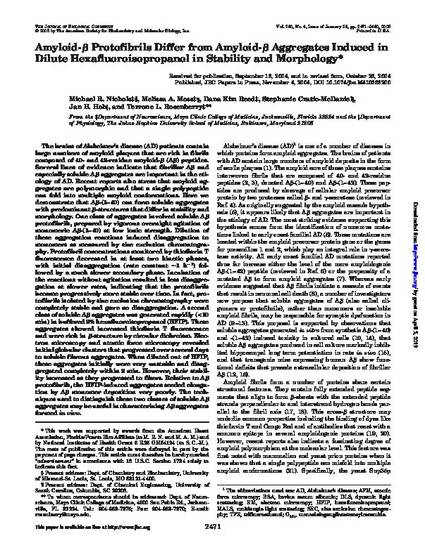
Article
Amyloid-β Protofibrils Differ from Amyloid-β Aggregates Induced in Dilute Hexafluoroisopropanol in Stability and Morphology
The Journal of Biological Chemistry
(2005)
Abstract
The brains of Alzheimer’s disease (AD) patients contain large numbers of amyloid plaques that are rich in fibrils composed of 40- and 42-residue amyloid- (A) peptides. Several lines of evidence indicate that fibrillar A and especially soluble A aggregates are important in the etiology of AD. Recent reports also stress that amyloid aggregates are polymorphic and that a single polypeptide can fold into multiple amyloid conformations. Here we demonstrate that A-(1–40) can form soluble aggregates with predominant -structures that differ in stability and morphology. One class of aggregates involved soluble A protofibrils, prepared by vigorous overnight agitation of monomeric A-(1–40) at low ionic strength. Dilution of these aggregation reactions induced disaggregation to monomers as measured by size exclusion chromatography. Protofibril concentrations monitored by thioflavin T fluorescence decreased in at least two kinetic phases, with initial disaggregation (rate constant 1 h1 ) followed by a much slower secondary phase. Incubation of the reactions without agitation resulted in less disaggregation at slower rates, indicating that the protofibrils became progressively more stable over time. In fact, protofibrils isolated by size exclusion chromatography were completely stable and gave no disaggregation. A second class of soluble A aggregates was generated rapidly (<10 min) in buffered 2% hexafluoroisopropanol (HFIP). These aggregates showed increased thioflavin T fluorescence and were rich in -structure by circular dichroism. Electron microscopy and atomic force microscopy revealed initial globular clusters that progressed over several days to soluble fibrous aggregates. When diluted out of HFIP, these aggregates initially were very unstable and disaggregated completely within 2 min. However, their stability increased as they progressed to fibers. Relative to A protofibrils, the HFIP-induced aggregates seeded elongation by A monomer deposition very poorly. The techniques used to distinguish these two classes of soluble A aggregates may be useful in characterizing A aggregates formed in vivo.
Disciplines
Publication Date
January 28, 2005
DOI
10.1074/jbc.M410553200
Publisher Statement
This research was originally published in the Journal of Biological Chemistry. Nichols. Amyloid-β Protofibrils Differ from Amyloid-β Aggregates Induced in Dilute Hexafluoroisopropanol in Stability and Morphology. J. Biol. Chem. 2004; 280:<<Page>>. © the American Society for Biochemistry and Molecular Biology or © the Author(s).
Citation Information
Michael Nichols, Melissa A Moss, Dana K Reed, Stephanie Cratic-McDaniel, et al.. "Amyloid-β Protofibrils Differ from Amyloid-β Aggregates Induced in Dilute Hexafluoroisopropanol in Stability and Morphology" The Journal of Biological Chemistry Vol. 280 Iss. 4 (2005) p. 2471 - 2480 Available at: http://works.bepress.com/michael-nichols/17/
